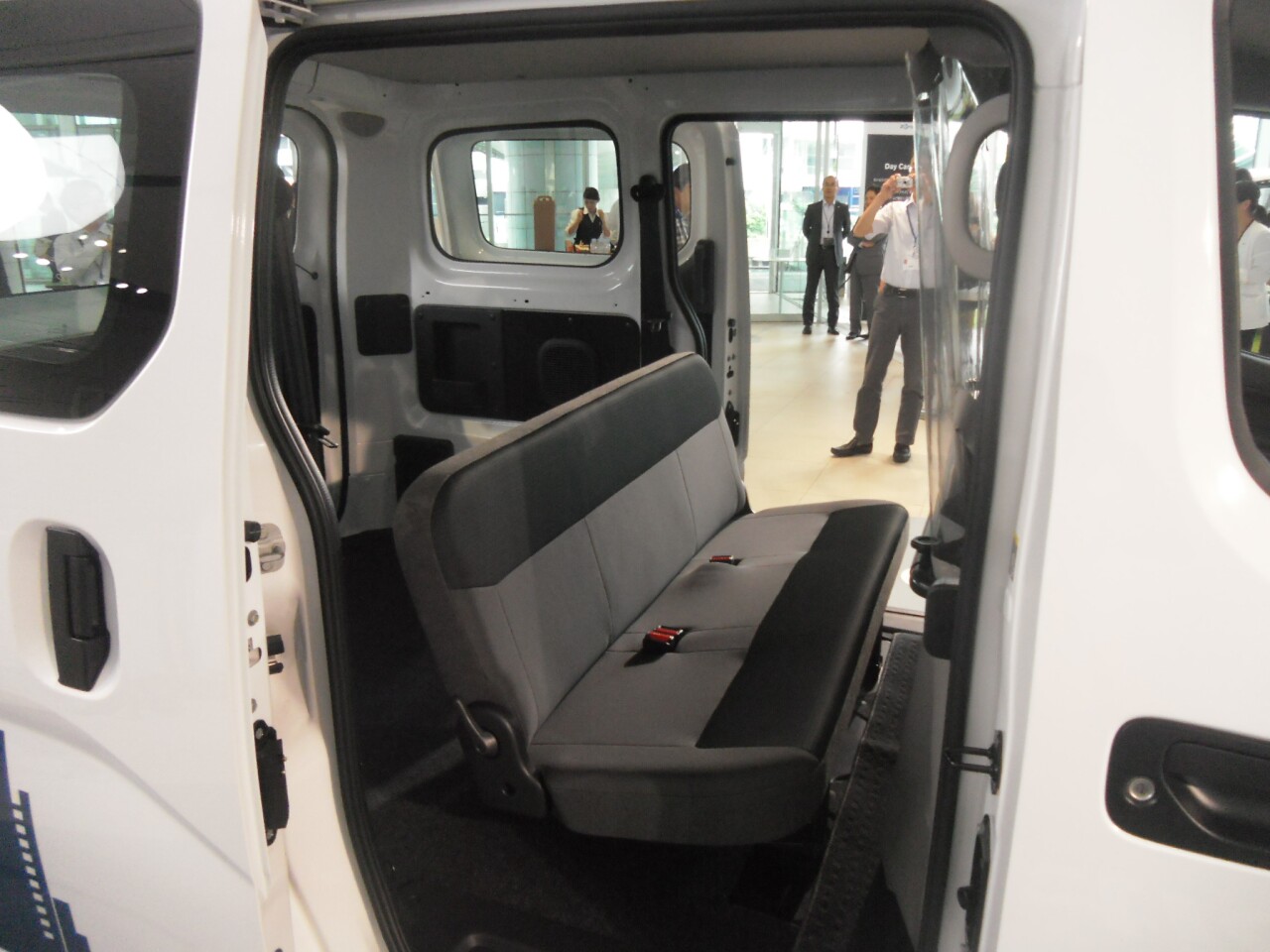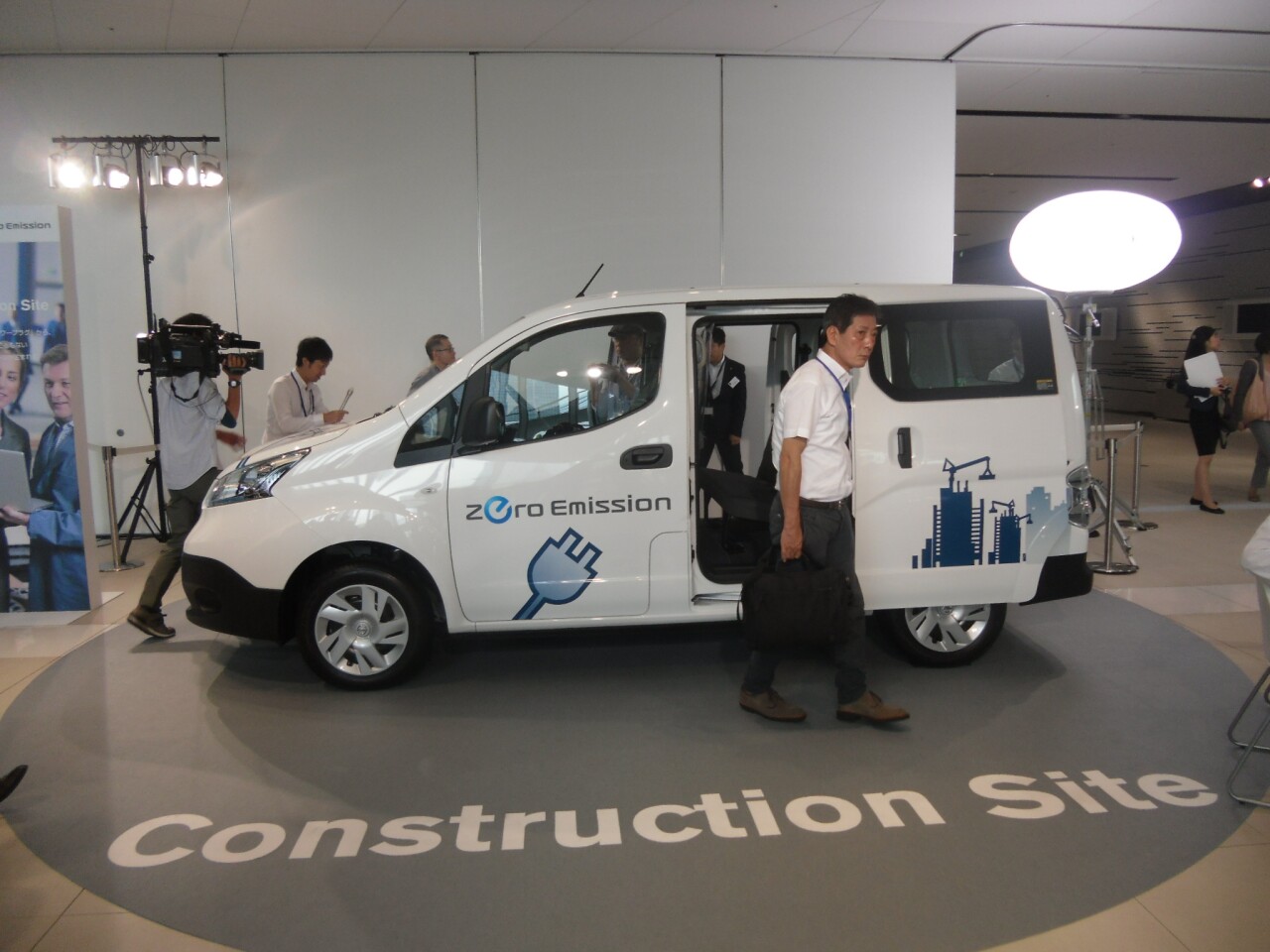In October this year, Nissan will enter the commercial zero-emissions vehicle market when its e-NV200 van goes on sale in Japan. The company officially introduced the vehicle during a launch display event at Nissan HQ in Yokohama, earlier this month. Gizmag dropped in for a closer look.
Nissan's new EV uses technology borrowed from its first zero-emissions vehicle, the LEAF. The e-NV200's styling has been changed from its gasoline powered brother in an effort to both differentiate it as the electric version and convey a family-friendly look.
The e-NV200 will be available as a five or seven seat wagon as well as a standard van, with or without rear side windows. Nissan says this will enable the e-NV-200 to appeal to commercial as well recreational users. The interior then can be optioned to your required number of seats which are all fold-able, including the front passenger seat.

Nissan says it has focused on technology that reduces energy consumption to enable the van to deliver a range of approximately 185 km (115 mi) and a top speed of 123 km/h (76 mph). This technology includes an accelerator pedal that reduces excessive pressure and also emits a clicking sound to warn of this excess. Also available as standard is an air con system that uses smart phone technology to either pre-cool or preheat the cabin. On cold days though, the standard fitment of a heated front seat together with a heated steering wheel, might be just enough to keep the cold at bay.

At the Yokohama launch display, Nissan was keen to highlight the van's potential uses within the light commercial vehicle market. Many of these displays emphasized the vehicle's ability to act as a mobile power source. With two power outlets and a maximum total output of 1500 kWh, electricity is available for both internal and external use. Nissan is also promoting the idea that the e-NV-200 can provide all the power to your office (or home) in emergencies.

The e-NV200 has an external length of 4560 mm, a width of 1755 mm, a height of 1850-5 mm and the internal volume figures remain almost the same from the gasoline NV-200. As in the LEAF, Nissan has installed the battery pack under the floor and mounted it centrally. This positioning not only maximizes interior space to 3600 liters but also gives the e-NV200 a good stable platform to carry loads of up to 600 kg.
Power is supplied by a 24 kWh battery pack to an 80 kW motor driving the front wheels. A full charge (in Japan) will take 8 hours from a normal outlet or just 30 minutes from a special quick charge installation, giving you an 80 percent charge.

Prices in Japan on launch are expected to be from 3,880,440 to 4,786,580 yen ($38,071 to $46,962) covering 8 variations of body and trim level. These figures do include consumption tax, but exclude government eco-car subsidies.
Product page: Nissan (Japan)
In October this year, Nissan will enter the commercial zero-emissions vehicle market when its e-NV200 van goes on sale in Japan. The company officially introduced the vehicle during a launch display event at Nissan HQ in Yokohama, earlier this month. Gizmag dropped in for a closer look.
Nissan's new EV uses technology borrowed from its first zero-emissions vehicle, the LEAF. The e-NV200's styling has been changed from its gasoline powered brother in an effort to both differentiate it as the electric version and convey a family-friendly look.
The e-NV200 will be available as a five or seven seat wagon as well as a standard van, with or without rear side windows. Nissan says this will enable the e-NV-200 to appeal to commercial as well recreational users. The interior then can be optioned to your required number of seats which are all fold-able, including the front passenger seat.

Nissan says it has focused on technology that reduces energy consumption to enable the van to deliver a range of approximately 185 km (115 mi) and a top speed of 123 km/h (76 mph). This technology includes an accelerator pedal that reduces excessive pressure and also emits a clicking sound to warn of this excess. Also available as standard is an air con system that uses smart phone technology to either pre-cool or preheat the cabin. On cold days though, the standard fitment of a heated front seat together with a heated steering wheel, might be just enough to keep the cold at bay.

At the Yokohama launch display, Nissan was keen to highlight the van's potential uses within the light commercial vehicle market. Many of these displays emphasized the vehicle's ability to act as a mobile power source. With two power outlets and a maximum total output of 1500 kWh, electricity is available for both internal and external use. Nissan is also promoting the idea that the e-NV-200 can provide all the power to your office (or home) in emergencies.

The e-NV200 has an external length of 4560 mm, a width of 1755 mm, a height of 1850-5 mm and the internal volume figures remain almost the same from the gasoline NV-200. As in the LEAF, Nissan has installed the battery pack under the floor and mounted it centrally. This positioning not only maximizes interior space to 3600 liters but also gives the e-NV200 a good stable platform to carry loads of up to 600 kg.
Power is supplied by a 24 kWh battery pack to an 80 kW motor driving the front wheels. A full charge (in Japan) will take 8 hours from a normal outlet or just 30 minutes from a special quick charge installation, giving you an 80 percent charge.

Prices in Japan on launch are expected to be from 3,880,440 to 4,786,580 yen ($38,071 to $46,962) covering 8 variations of body and trim level. These figures do include consumption tax, but exclude government eco-car subsidies.
Product page: Nissan (Japan)





















